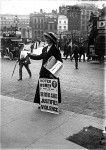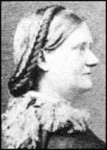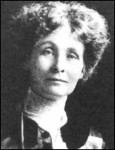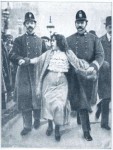 Ahead of tonight’s episode of Find My Past, which is looking at the suffragette movement, I thought it would be interesting to have a look at the history of female suffrage, and to contemplate on ancestors who may have been suffragettes or suffragists themselves.
Ahead of tonight’s episode of Find My Past, which is looking at the suffragette movement, I thought it would be interesting to have a look at the history of female suffrage, and to contemplate on ancestors who may have been suffragettes or suffragists themselves.
Firstly, let’s travel back to the middle of the 19th century. Here are some facts about the situation of women at this time:
- Women could not vote.
- They were excluded from most jobs apart from low paid domestic service or menial work.
- A woman was legally ‘owned’ by her husband.
- She could not divorce.
- Everything she owned belonged to her husband.
- She received less education than men.
- The only other way for a woman to be independent was to be a rich widow.
- Her sole purpose in life was to marry and reproduce.
While she did not support the female vote, Florence Nightingale did have some strong views on women’s rights, and said:
‘Why have women passion, intellect, moral activity – these three – and a place in society where not one of the three can be exercised?
Middle class women were expected to pursue gentile activities, such as embroidery. The only job a middle class girl could aspire to would be as a governness – a very low-paid, demeening job, only taken if the woman remained unmarried and the family fell on hard times. However, working class women had to do tough menial work, as well as bring up often large numbers of children.
When you look at married women in the census records, you may often notice that the occupation column is often left blank. This does not always mean that they did not do some kind of paid work. It really means that a married woman’s work was unrecognised as long as the man had a job.
The status of women was sanctioned by church, law, custom and history. It was therefore very difficult to rebel against such a situation, and if any woman did, she was swiftly and easily crushed by fathers, husbands or brothers.
All this sounds dreadful – but actually most women accepted this state of affairs as normal. If they did feel inhibited, it was with a sense of resignation.
The early feminist movements.
 At around this time there were women who were beginning to rebel against this state of affairs. Barbara Leigh Smith Bodichon wrote a pamphlet in 1854 and formed a committee with other feminists to try and change the law giving married women rights to their own property. They formed a petition which they presented to the House of Lords with 26,000 signatures in our year, 1856. This was the first organised feminist action in the UK. It was, of course, rejected.
At around this time there were women who were beginning to rebel against this state of affairs. Barbara Leigh Smith Bodichon wrote a pamphlet in 1854 and formed a committee with other feminists to try and change the law giving married women rights to their own property. They formed a petition which they presented to the House of Lords with 26,000 signatures in our year, 1856. This was the first organised feminist action in the UK. It was, of course, rejected.
Yet, a year later, with further pressure, the Married Women’s Property Bill was passed in the Commons. This meant women could now keep their own property after marriage. After this, the women’s suffrage movement was born, and continued to develop, with the support of MP and philospher, John Stuart Mill, and dominated by the work of Lydia Becker and Millicent Fawcett.
Over the following years, further Acts were passed that improved the lives of married women. They could divorce on grounds of cruelty – and have custody of their own children.
More work opportunities also became available, particularly after the invention of the typewriter in the 1860s. If you find that your female ancestor had an office job from 1861 onwards, it may be that they were very forward thinking, and possibly active in the campaign for women’s suffrage.
The suffrage movement gathered pace in the 1860s, with one of the main aims being for women to have the vote. Of course, there was a great deal of resistance, and not just from men. Many women did not actually want the vote, and believed that men and women should function in two separate spheres.
 In the early years of the 20th century, the movement became split, and the militant phase of the suffragettes started, led by the Pankhurst family. Beginning with negotiations, demonstrations, hackling MPs during public meetings and attempting to enter the House of Commons, it soon moved on to throwing stones, setting fire to pillar boxes and attacks on golf greens. Sometimes the houses of cabinet ministers were attacked.
In the early years of the 20th century, the movement became split, and the militant phase of the suffragettes started, led by the Pankhurst family. Beginning with negotiations, demonstrations, hackling MPs during public meetings and attempting to enter the House of Commons, it soon moved on to throwing stones, setting fire to pillar boxes and attacks on golf greens. Sometimes the houses of cabinet ministers were attacked.
When the 1911 census was taken, many women who supported the movement refused to take part, staying away from their homes and sleeping rough on the night of the census so they would not be included. If you cannot find a female ancestor on this census, it could be a clue that your relative was a supporter.
In 1913 it looked as though a bill supporting the female vote was about to be read in parliament, but when it was dropped because of this inclusion, the Women’s Social & Political Union stepped up their aggressive campaign. Active suffragettes were arrested and sent to gaol, where they went on hunger strikes and underwent forced feeding.
 In political terms it can be argued that this militant phase did very little to improve the cause. Furthermore, there were disagreements and splits within the organisation. Many women did not agree with the autocratic way the Pankhursts ran the organisation.
In political terms it can be argued that this militant phase did very little to improve the cause. Furthermore, there were disagreements and splits within the organisation. Many women did not agree with the autocratic way the Pankhursts ran the organisation.
The tactics of the militant movement alienated many working men and women, and furthermore, their cause was eclipsed by various political crises, such as strikes, prospect of an Irish civil war and a naval race with Germany.
Feeling let down by the Liberal Government, many suffragists moved the allegience to the Labour party, which at that time had a small impact in parliament.
The First World War
When the First World War began in 1914, it looked at first that women’s suffrage would be overshadowed by events. The militant campaign was brought to an end, and the Pankhursts involved themselves in a war recruiting campaign.
However, it helped the cause more than anyone could have foreseen. Firstly, it brought Lloyd George to leadership, a man far more sympathetic to female suffrage than Asquith had been.
Secondly, the contribution that women made to the war effort made people more aware of their capabilities.
The General Election of 1918 called for a review of the franchise. Many householding men had been called to war, and had lost their ability to vote, so reducing the electorate. The enormous loss of life further compounded the problem. This led to changes in the system, and it also meant that they looked again at the reform Bill of 1913 – including the enfranchisement of women. A concession was given – and women over the age of thirty, who were on the local government register, or who were wives of men who occupied property, or graduates of university, were given the vote.
This meant that over 8 million women were enfranchised: 40% of the new electorate.
However, many of the women who had campaigned for the vote, or who had contributed to the war effort were under 30 – so still could not vote, which caused some dissatisfaction. It was not until 1928 that women had the same voting rights as men.
If you think you might have a suffragette in your ancestry, it would be useful to look at newspaper archives, which are increasingly online now. The new British Newspaper Archive holds a range of newspapers from across the UK.
The National Archives also have a large collection of suffragette records, including a list of suffragette prisoners 1905-1914.
If you do find that you have an ancestor who supported female suffrage, then you have a great reason to be proud. Also, if you had a female ancestor who did a job that was usually only thought of as man’s work, or who had some academic achievement – then you should feel equally as proud. These brave and free-thinking women paved the way for women of today to have the choice of a career and a political voice.
So Here’s to my Great Aunt Maud, who I believe was Head of a Department at Lewis’s of Manchester in the 1900s. I do hope she was a supporter of the Suffragettes movement!
For research across the UK, take advantage of my December discount, details HERE

